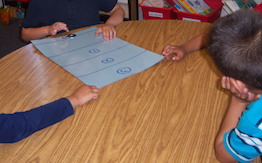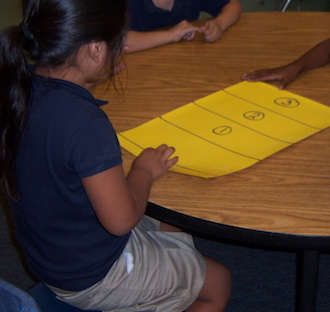






Objects do not move on their own.
Conduct an investigation to collect data about the effect of the strength of push on an object.
Discs move different distances.
Click here for NGSS, CCSS-ELA, and California ELD standards.
How can we change the distance a disc travels?
In Lesson 2: Pullapalooza, students solved a soccer coach’s problem of moving soccer objects to the field. At the conclusion, students generated a list of questions they need a solution for to be able to make a motionless soccer ball score a goal.
This lesson answers student questions about how to push the ball harder or faster. This deepens their understanding of movement by describing the strength of a push. (DCI) The investigative phenomenon is “Discs move different distances.” The investigative phenomenon is observed in a video of shuffleboard. The investigation is a mini-shuffleboard game where the cause and effect of different-strength pushes result in what score you get. Students gather data about the push used and look for patterns to predict distances. (CCC) (SEP) Understanding that different pushes result in different distances traveled by a disc in shuffleboard deepens understanding of the anchoring phenomenon that motionless objects won’t move on their own.
This exploration leads to the next lesson, Lesson 4: Huff, Puff, and Move the Ball, an exploration of how the wind creates a push changing the speed and direction of an object.
Throughout the lesson, a flag ( ) denotes formative assessment opportunities where you may change instruction in response to students’ level of understanding and making sense of phenomena.
) denotes formative assessment opportunities where you may change instruction in response to students’ level of understanding and making sense of phenomena.
Parts represent different sessions on different days for kindergarten.
| Part I | 45 minutes | |
| 10 minutes | Engage | |
| 25 minutes | Explore I | |
| 10 minutes | Explain I | |
| Part II | 30 minutes | |
| 20 minutes | Explore II | |
| 10 minutes | Explain II | |
| Part III | 30 minutes | |
| 20 minutes | Explore III | |
| 10 minutes | Explain III | |
| Part IV | 10 minutes | |
| 10 minutes | Elaborate/Evaluate |
Observe effects of pushing shuffleboard discs towards a goal.
You may want to pause the video a few times and ask the students questions about how the disc moved. “What did the boy use to move the disc? Did they push it or pull it? Did the disc move the same distance every time?”
Carry out an investigation to determine if different amounts of force cause a disc to move different distances.


In order to get the disc to Box 2, I predict that I will _____.
Once students have figured out how to get the disc in Box 1, their discussions should include greater push or lesser push rather than harder and weaker/softer. This is an opportunity to refine their language using push, and greater push, greatest push to show changes in force. The collaborative plan also supports English Learners as they share ideas to develop the plan.
Compare data from observations that show the effect of different strength of pushes to the distance the disc traveled.
Use the word supported because that is how scientists would describe the results of the test. The observations students made would support (or not support) their predictions. Avoid words such as right/wrong or good/bad as these imply value judgments. Have a discussion with students about what the word accurate means.

Carry out an investigation to determine if strength of of a push affects speed.
Compare data from observations that show the effect of different strength of pushes on the speed of the ball.
A bigger push or pull results in greater speed. In this case, speed is represented by the first disc to cross the line at the end of the shuffleboard. (using relative time appropriate to kindergarten.)
 Distribute K.3.H1: Sandy and Diego. Orient students to the handout names and figures.
Distribute K.3.H1: Sandy and Diego. Orient students to the handout names and figures.
Monitor students while they work and look for examples of student work to share. Look for a couple of examples that show a greater push with a longer arrow. The game board for shuffleboard can be placed in the choice centers for at least a week to encourage the use of the academic language and comprehension that a greater push causes a longer distance traveled and a lesser push causes a shorter distance traveled. The choice centers could include words on cards such as greater push, greater distance, less push, less distance to encourage high-level students to read and label the results.
Predict and observe the cause of making an object stop its movement.
Compare predictions to observations of how pushing an object can cause the object to stop.
Compare observations linking the results of pushing with different strengths or stopping movement to soccer moves.
 Say, “Let’s think about how we pushed the disc and stopped the disc. How can that help us in a real soccer game if we want to move the ball to the goal?” Have students draw a picture in their science notebook showing how to push the ball farther, push the ball closer, and stop the ball.
Say, “Let’s think about how we pushed the disc and stopped the disc. How can that help us in a real soccer game if we want to move the ball to the goal?” Have students draw a picture in their science notebook showing how to push the ball farther, push the ball closer, and stop the ball.Place the game boards in the choice centers for several days. Listen to students using language that describes movement.
Encourage connections from the disc experience to soccer, especially harder kicks increasing speed and distance. The movement continues unless something stops the movement with a backward push. This might be another player or the goalie. Students still do not know to use other players (collisions) or factors like weather that might cause changes in the way the ball moves.
It would be appropriate to have students interact with text to extend their understanding of pushes. These selections can be read aloud at any time after this lesson where students have experienced pushes. Suggested books include the following:
Fiction:
Alborough, J. (2014). Duck in the Truck. Tulsa, OK: Kane Miller.
Merz, J. J. (2007). Playground Day! New York, NY: Clarion Books.
Shaw, N., & Apple, M. (2019). Sheep in a Jeep: 5-Minute Stories. Boston: Houghton Mifflin Harcourt.
Toddgabweg. (2017, May 14). Shuffleboard video. Retrieved from https://www.youtube.com/watch?v=XBsj3HqYx9M